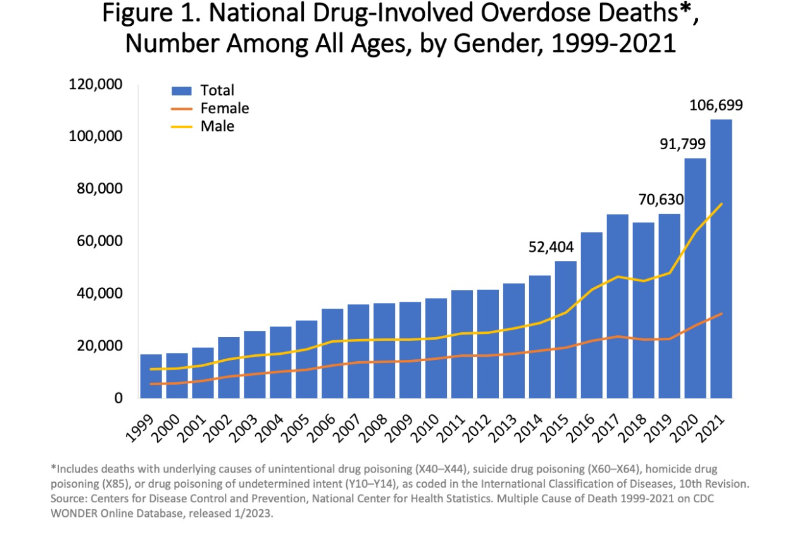Opioids: Everything you need to know about the uses and dangers of opioids!
Published 26 Jun 2023 • By Polina Kochetkova
Due to its ability to relieve pain, opioids have been used extensively in medicine for ages. But its abuse and addiction have created a worldwide narcotics issue that has harmed countless people and families. Today, we talk about the uses and dangers of opioids.
How are opioids used in the medical field? What dangers do opioids have? Why is the opioid crisis a global concern?
Keep reading to find out!

How do opioids work and when are they used?
Opioids are a group of strong medications that are typically administered to treat intense pain. They work by interacting with certain receptors in the brain and spinal cord to change how pain is perceived. Opioid receptors, which are mostly present in the central nervous system (CNS), are what opioids attach to, blocking the sensations of pain.
Some of the prescription opioid medications are:
- Hydrocodone
- Oxycodone
- Oxymorphone
- Morphine
- Codeine
- Fentanyl
Opioids are most frequently used for pain reduction in a variety of therapeutic contexts, including treatment of acute and chronic pain. When treating severe pain that does not respond to conventional analgesics, these drugs are extremely effective. However, because of the risk of dependency, tolerance, and addiction, their usage should be closely supervised.
Some of the cases when opioids can be used include:
- Surgical Procedures: To manage pain and guarantee patient comfort, opioids are commonly given prior to, during, or after surgical operations. Depending on the kind of operation, they may be administered via an IV, intramuscularly, or epidurally.
- Extreme Trauma and Emergency Care: Opioids may be used in critical situations to manage acute pain brought on by traumatic injuries or severe medical conditions. To balance the advantages of opioids with potential dangers and side effects, caution is necessary.
- Pain associated with cancer: People with advanced cancer frequently feel excruciating pain that dramatically lowers their quality of life. Opioids are frequently recommended to relieve cancer-related pain and improve patient well-being. They come in immediate-release and extended-release varieties.
- Terminal care: Opioids are essential for managing difficult symptoms such as excruciating pain, dyspnea, and anxiety in palliative and end-of-life care patients. During this tough period, they support patients' comfort and improve their general quality of life.
It is very important to discuss with your doctor the compatibility of prescribed opioids with other medications you might be taking, as such drugs have a high incompatibility with opioids.
Avoid drinking alcohol when using opioids. Combining these drugs with alcohol may cause you to become even more sleepy and raise your chance of experiencing additional negative side effects.
What are the dangers of opioids?
When using prescribed opioids, it is very important to know their dangers and possible side effects as it is a highly addictive group of pharmaceuticals.
Increased tolerance
People who take opioids over an extended period of time may become less responsive and require bigger dosages to get the same amount of pain relief. This enhanced opioid sensitivity can result in higher dosages and perhaps dose-dependent adverse effects. To successfully treat pain and reduce the risk of tolerance-related problems, regular monitoring and dosage modifications are essential, as well as looking into non-opioid alternatives.
Addiction and dependency
One of the most obvious risks associated with opioids taken for medical purposes is the potential for addiction and dependence. Long-term opioid usage can develop physical dependency, which can cause withdrawal symptoms when stopped. Additionally, some people may have opioid use disorder (OUD), which is characterized by compulsive drug use and a lack of control. The potential for addiction must be weighed against the advantages of pain treatment, and individuals undergoing opioid medication should be thoroughly examined for risk factors.
Reduced cognitive function
Opioids have the potential to make users drowsy and sedentary, which affects cognitive and psychomotor abilities. Opioid users may have trouble paying attention, remembering things, and making decisions, which raises the possibility of accidents and injury. It is not recommended to operate machinery or drive a vehicle when using prescribed opioids.
Digestive problems
Constipation, which can be severe and chronic, is a typical gastrointestinal side effect of prescribed opioids. Chronic opioid usage may result in opioid-induced bowel dysfunction (OIBD), which can include nausea, vomiting, and abdominal pain as well as bowel blockage.
Opioid overdose
Because opioids affect the area of the brain that controls respiration, using them can result in fatality. Three signs and symptoms, when combined, can indicate an opioid overdose:
- Smaller pupils
- Unconsciousness
- Breathing issues
- Change of color in lips or/and fingertips
- Vomiting or making gurgling noises
If a person close to you has any of the mentioned symptoms it is crucially important to call the Ambulance service on 999.
In parallel with an increase in opioid-related mortality and the number of individuals seeking treatment for opioid prescription addiction, England has seen a significant rise in the prescribing of opioids. While opioid mortality rates in England have not yet surpassed those in the US, both the effects and mortality associated with opioid usage have grown over time. As a result, rather than being a public health emergency as it is in the US, the situation in the UK can be described as an opioid epidemic.
It's important to know that anyone who takes opioids on prescription risks addiction.
Why is the opioid crisis a global concern?
Since 2000, more than a million people in the United States have died of drug overdoses, the majority of which were due to opioids.
For decades the main cause of opioid overdose was heroin. Heroin is a narcotic, which is never used for medical needs. However, Fentanyl, a synthetic opioid that is around fifty times stronger than heroin, has recently become the symbol of the issue. The opioid crisis, according to analysts, began with the overprescription of legal painkillers, but it has gotten worse in recent years as a result of the illegal importation of cheap heroin and synthetic opioids like fentanyl. The situation has grown to such proportions that it now threatens national security and places a serious strain on the economy.

Source: National Institute of Drug Abuse
In the United States, drug-related overdose deaths increased to over 106,000 in 2021, including deaths caused by both illegal and prescribed opioids.
In 2019, the UK had the highest opiate usage rate in globally, and opiate-related drug overdose fatalities had grown by 388% in England and Wales since 1993.
National statistics state that 57% of individuals in England needing addiction help because of opiates had a housing issues, while 30% of them required mental health therapy. Chemical dependency treatment can be combined with programmes that support housing and employment as well as physical, mental, and social needs.
According to a 2021 Cambridge University study, in Europe, apart from the British Isles, and particularly Scotland, none of the 19 European countries included in this analysis showed signs of an opioid problem equivalent to that in the US. To pinpoint causes and create treatments to halt the escalating opioid problem in the UK and Ireland, more study is required.
However, given the scope and severity of the synthetic opioid epidemic in North America and the likelihood that it will eventually spread to other areas of the world, supply control measures, even those that are only partially successful and ineffective, can still save lives. For this reason, they must be created with the greatest amount of intelligence and sturdiness.
Overall opioids can help to ease great pain, yet have a variety of dangers, which should be discussed with your doctor before starting the treatment. It is important to use opioids with caution and under medical supervision.
Give it a "Like" and share your thoughts and questions with the community in the comments below!
Take care!
Sources:
Prescription Opioids: The Basics, National Institute of Drug Abuse
Opioids, Cleveland Clinic
Opioids in palliative care, Healthify.nz
Drug Overdose Death Rates, National Institute of Drug Abuse
Dose of Reality: Opioid Overdose, Wisconsin department of Health Services
Is Europe facing an opioid crisis like the United States? An analysis of opioid use and related adverse effects in 19 European countries between 2010 and 2018, Cambridge.org
Is England facing an opioid epidemic?, British Journal of Pain
Adult substance misuse treatment statistics 2020 to 2021: report, Gov.uk

 Facebook
Facebook Twitter
Twitter


